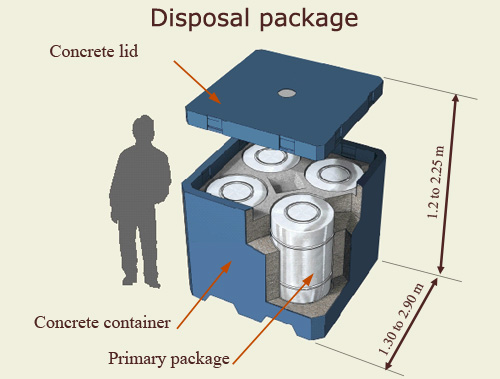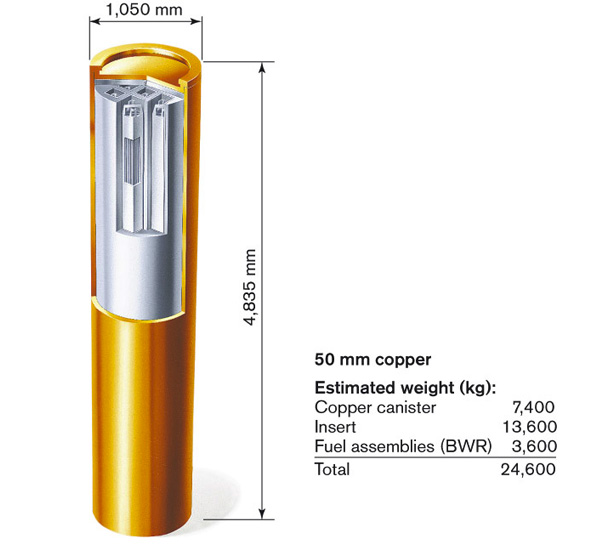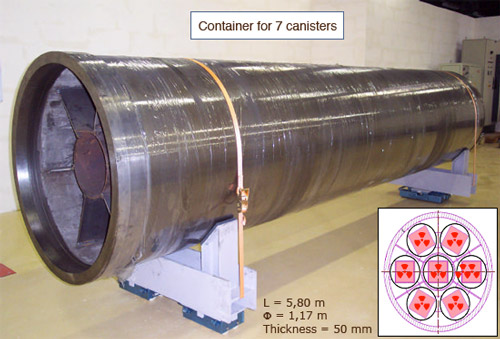Radioactive Waste Containers
Canisters and containers for various types of waste

Concept of container for intermediate-level waste
Demonstrators for concrete containers that can be used for two purposes, the storage of primary packages of intermediate-level long-lived waste (ILW-LL) and their disposal, have been jointly studied by CEA and ANDRA. The containers are made of a special type of concrete, which is different from the type proposed for the structure of the storage and disposal facilities. More results are still needed for cemented packages and further research has to be carried out, particularly to consider the implications of cracking.
© CEA/ANDRA
France’s National Evaluation Commission (CNE) took the view in its final report that the conditioning of primary packages of high-level (HLW) and intermediate-level (ILW-LL) waste was well understood and that the field had reached industrial maturity. These primary packages are made up of vitrified waste and compacted waste produced at La Hague. The CNE believes that the conditioning of both categories of waste is appropriate for their geological disposal, provided that containers are also added.
Adding containers means putting primary packages and other types of radioactive packages into suitable canisters and containers to form a separate barrier, which is essential for safety during both storage and disposal.
Demonstrators have been made for storage containers for primary packages of intermediate-level waste (ILW-LL), high-level waste (HLW) and spent fuel assemblies. Their durability will be studied in accordance with the requirements of the long-term storage facilities planned to accommodate this waste.
Teams at CEA (the French Alternative Energies and Atomic Energy Commission) have designed separate solutions for packages that do not emit heat and for those that do – spent fuel assemblies and vitrified waste packages. For packages that do release heat, a model-based study of their durability and ability to remove heat is in progress.
With packages of intermediate-level long-lived waste (ILW-LL), tests have shown that the radioelements they contain could not be recovered for transmutation and that they are therefore the final waste (they only account for a few % of the total activity). Since these primary packages do not release any heat, the proposal was made to place them in durable concrete containers that could be used both for storage and disposal. Demonstrators for these dual-use containers have been made by CEA and ANDRA.
they contain could not be recovered for transmutation and that they are therefore the final waste (they only account for a few % of the total activity). Since these primary packages do not release any heat, the proposal was made to place them in durable concrete containers that could be used both for storage and disposal. Demonstrators for these dual-use containers have been made by CEA and ANDRA.

Sweden: copper canisters for disposal
Sweden, which does not intend to reprocess its spent fuel, has developed a disposal process. Carbon steel assembly containers are inserted into over-pack containers with a copper outer shell. The overpacks designed for waste disposal in granite, which is the only suitable geological formation available in Sweden, will be placed in cells that are backfilled with bentonite, a clay that becomes totally impermeable when saturated with water, preventing any water that naturally circulates through the granite from reaching the waste packages.
© SKB
Containers for spent fuel and vitrified waste
Fuel assemblies, which are 4-metre long, mechanically vulnerable structures containing a fragile matrix of irradiated uranium oxide pellets, require for their storage and disposal a system of canisters and containers. CEA has designed containers that can accommodate 7 UOX assemblies or 4 MOX assemblies, which release more heat. The individual canister is made from stainless steel and is sealed by welding. It uses well understood industrial technologies.
Sweden, which will be one of the first nations to bury its spent fuel, has chosen to use large copper containers for the assemblies taken out of its reactors. Copper has been chosen for its corrosion resistance. These containers, when full, will weigh 25 tonnes.

Spent fuel assembly containers (project)
The prospect of storage and disposal facilities for spent fuel has prompted CEA to design models of very large containers that can accommodate several fuel assemblies. The assemblies themselves, which are long and fragile, are placed in canisters which are in turn placed in a welded stainless steel container. This acts as a second barrier. The inside of the canister and the container are filled with a dry, inert gas, minimising the risk of internal corrosion in the long term.
C© EA
Finally, the containers for packages of vitrified high-level waste would be similar in design to those for spent fuel assemblies. For example, a CEA project is looking at containers that can hold six UC-V (CDS-V) packages.
However, in the CNE’s view, there is still further research and work to be done on the containers to be used for waste packages and spent fuel assemblies. Their specifications have not yet been defined.
NEXT : Studies of long term behaviour
Learn more :Intermediate-level waste (ILW-LL)
Vitrified packages (HLW)
Intermediate-level waste (ILW-LL)
SKB web site (Sweden)
Other articles on the subject « Waste Conditioning »
Vitrified High Level Waste
Glass – A very resistant matrix for high-level waste After the uranium and plutonium have b[...]
Resistance of R7T7 glass
Assessing the resistance of vitrified waste over millennia Is nuclear power a clean industry? To [...]
Conditioning Spent Fuel
Underground disposal of spent fuel – A long-term option Spent fuel assemblies unloaded from react[...]
Packaging Intermediate-level waste
Compaction for hulls and end caps… The zirconium alloy cladding around the uranium oxide pellets [...]
Low and very low level waste
Basic conditioning for low-level and very low-level waste Waste in which the radioactivity is low[...]